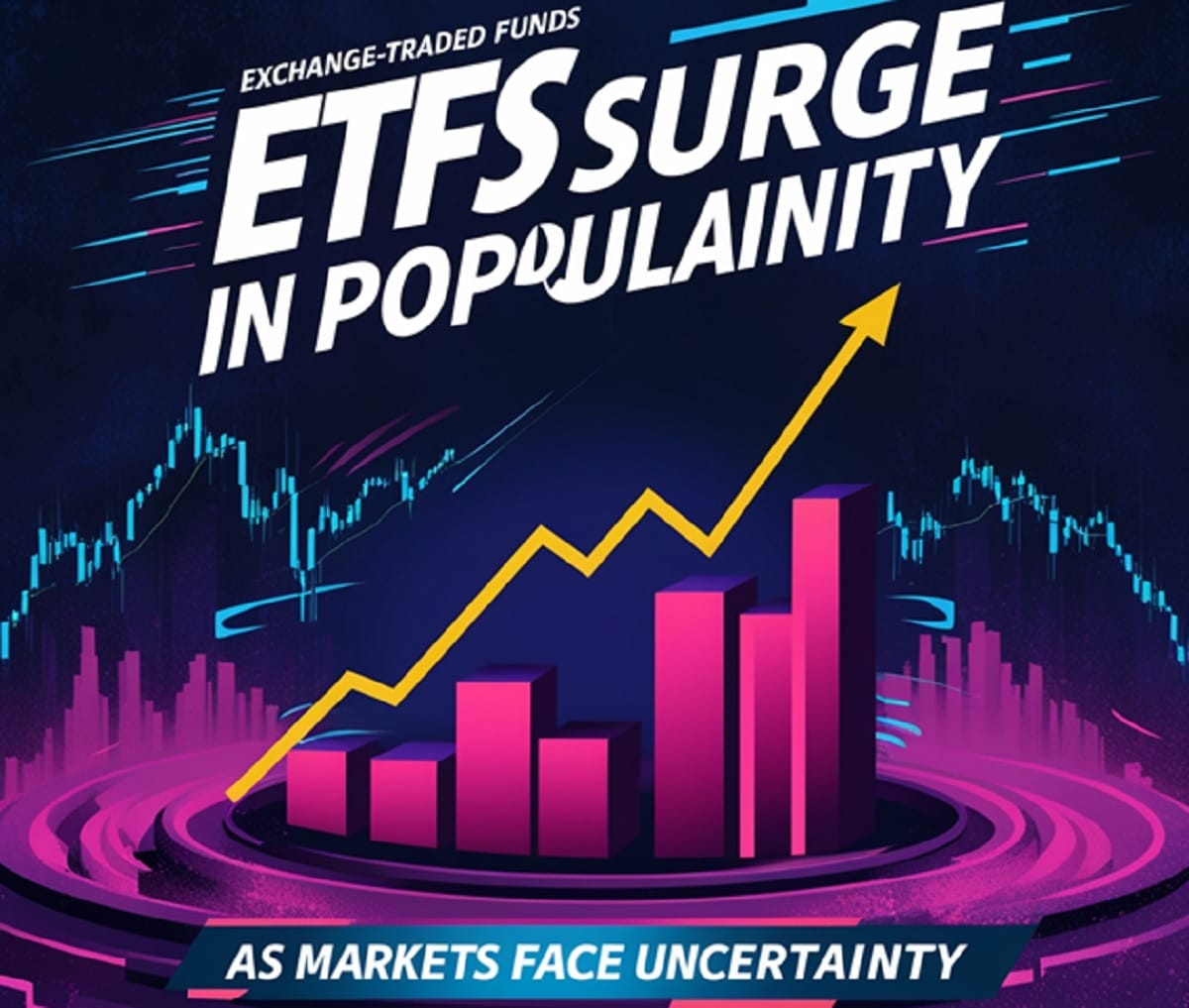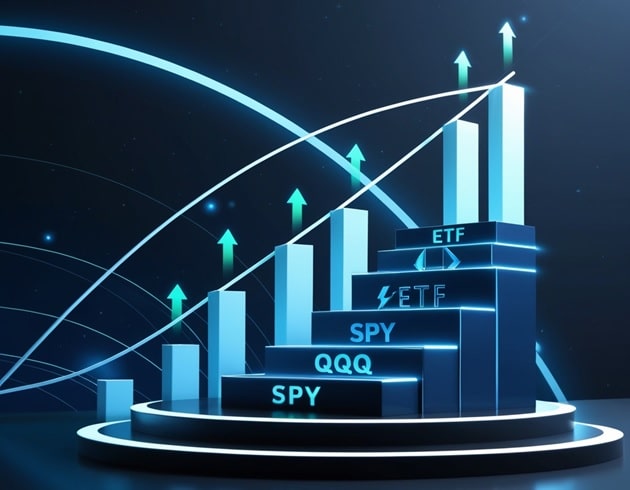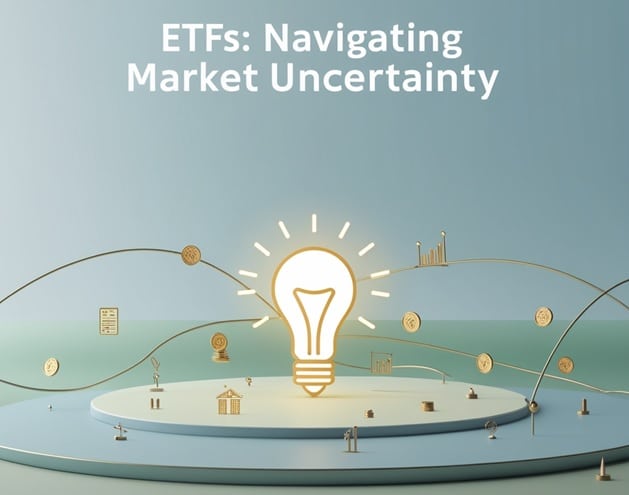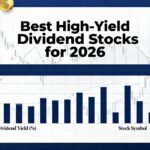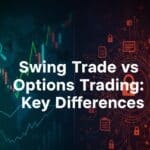ETFs gain significant market popularity through their flexible structure and low-risk features during periods of investment uncertainty in current economic volatility.
The current economic uncertainty has begun to produce increasing levels of investor distress. Numerous investors look for alternative investment options that provide security and adaptability due to ongoing market unpredictability and rising prices as well as declines in economic trends.
Contemporary financial markets show significant turbulent behavior because stocks and bonds fail to maintain previous levels of investment safety. A market uncertainty environment triggers unpredictable movements within financial markets which causes fear among investors.
During unstable market conditions investors face an ongoing challenge of finding suitable protection for their values and potential ways to achieve success.
Introduction to ETFs
Exchange-Traded Funds (ETFs) introduced a new investment vehicle which is presently expanding at a quick rate. Exchange-Traded Funds (ETFs) became popular because investors use them for their combination of accessibility and low pricing structure and market versatility.
Exchange-traded funds combine both stock investment benefits with mutual fund diverse selection features to provide many strategies suitable for investors.
ETFs gain widespread popularity among investors because they supply market flexibility with risk management capabilities during times of unknown market conditions.
Understanding ETFs
The Exchange-Traded Fund (ETF) functions as an investment fund that operates on stock markets and trades similarly to basic stock securities.
ETFs compose of holdings that include stocks or commodities or bonds which maintain their net asset value through an arbitrage system accessing near-NAV levels but may show price differences from time to time. With ETFs investors combine their financial resources to build a diverse portfolio of assets that can be obtained without requiring individual purchases of each asset.
Types of ETFs
Strategic investment needs can be achieved through different types of exchange-traded funds which match diverse approaches. The most popular ETF categories consist of the following three groups:
- Stock ETFs: Stock ETFs include funds that track the performance metrics of selected indexes which include both S&P 500 and NASDAQ. Such funds let investors access many different businesses across numerous industries which explains their widespread investor appeal for portfolio expansion.
- Bond ETFs: Individuals can access fixed income through bond exchange-traded funds that offer bond investments. Investors add stable assets to their portfolios through these ETF instruments because they produce lower volatility.
- Commodity ETFs: These ETFs buy and sell physical commodities such as gold and oil and agricultural products. ETFs connected to commodities provide great appeal when markets become unpredictable or suffer from inflationary periods.
- Sector ETFs: ETFs targeting specific industries in the economy fall under the category of sector funds which focus on technology, healthcare or energy sectors. Investors adopt sector ETFs to put their capital into specific industries which they believe will lead the market performance.
- International ETFs: ETF investors can access international markets through these funds which expand opportunities to diversify across international markets. These ETF investments concentrate either on developed market activities or emerging market opportunities.
Structure
ETFs function as an open-ended fund because their trading share numbers remain variable. Authorized participants who are generally institutional investors use their creation and redemption power based on what investors want to buy or sell. ETFs operate on stock exchanges the same way as stocks do because investors can purchase and sell these instruments all day at market values that slightly differ from their NAV.
Most ETFs are managed passively since they match specific indexes whereas mutual funds depend on portfolio managers to direct their investments. The passive nature of ETF investment allows investment managers to charge lower fees instead of mutual fund management expenses.
The Rise in Popularity of ETFs
Market Conditions Leading to Surge
The uncertain nature of market conditions together with high volatility has made traditional investment methods less attractive for investors during recent years.
Several financial factors such as volatile stock market conditions and economic changes and geopolitical conflicts and inflationary risks create an environment where investors now look for diversified stable investment choices.
The current market environment has led multiple investors to choose ETFs because of their attractive benefits. ETFs provide investors with a combination of diverse investments together with affordable fees and adaptable features which proves most beneficial in moments of economic instability.
The uncertain global market environment encourages investors to shift their funds towards ETFs because these products provide risk reduction alongside an extensive range of investment options. ETFs operate as risk-management tools by protecting investors from surging unpredictability within stock sectors and individual businesses during market volatility.
Statistics/Trends
ETFs have experienced dramatic popularity growth since the beginning of the last decade. The $10 trillion threshold of global ETF assets was recently achieved by the industry according to reports while ETF numbers continue to rise annually.
ETF inflows in 2024 have established new annual records because investors choose ETFs for their combination of diversification and market liquidity benefits. ETFs currently make up a major share of total trading activity on major stock markets and their growth shows no indication of stopping.
Investor Sentiment
ETFs have gained popularity among investors because they provide both risk-spreading benefits and convenient accessibility along with economical services. Modern investors who belong to younger demographics play a major role in changing investor sentiment while seeking out inexpensive flexible investment alternatives.
The new generation of investors prefers ETFs because they use digital platforms for investments and seek low management costs as well as comprehensive transparency and worldwide market accessibility.
Financial advisors together with institutions now frequently endorse ETFs to their clients because these investment products offer broad exposure to different asset classes while being easy to manage and presenting lower risks during market turbulence.
Benefits of ETFs During Market Uncertainty
Diversification
The main benefit of ETFs stems from their power to offer diversification to investors. Uncertain market conditions make the distribution of investments across various sectors or asset classes work to minimize risks associated with individual investments. ETFs provide investors with an opportunity to invest in multiple assets through a single investment beyond traditional stock and bond purchasing.
A stock ETF simultaneously distributes its investments across hundreds of companies thus giving investors instant portfolio diversification without requiring separate stock purchases. Broad market ETFs deliver stability to investors specifically during times of market volatility since their sector-wide investments safeguard against individual stock performance declines within specific sectors.
Liquidity
ETFs stand out because they maintain excellent liquidity qualities which allows investors to purchase or sell them during normal market hours at their current value. ETFs provide investable liquidity unlike mutual funds because they allow continuous trading during stock market operation hours. Quick investor responses to market changes become possible through ETF liquidity since market conditions require fast decision-making during uncertain times. The extensive tradability of well-known ETFs enables continuous market participation especially when the market experiences high volatility.
Low Costs
The expense ratios for ETFs remain lower than they do for conventional mutual funds. Sustainably managed ETFs maintain passive operations because they follow market indices or specific asset categories instead of choosing individual stocks. ETF management provides investors with reduced operational fees because of its passive approach to fund operations. During uncertain market times each dollar matters more so investors select ETFs because they have a less expensive structure.
Accessibility
The use of Exchange-Traded Funds provides common investors with simplified access to many different types of assets. ETFs enable investors to access a broad range of asset classes because there exists an ETF that offers exposure to stocks bonds commodities as well as international markets. People can buy ETFs through any standard brokerage platform even when investments start from modest amounts.
The open accessibility of ETFs draws retail investors because they do not need significant purchasing power to invest. A single ETF lets investors gain exposure to a diverse portfolio solution therefore making investment opportunities more reachable to a wider group of people.
Risk Factors of ETFs
Market Volatility
ETFs tend to be regarded as safer than individual stocks but they stay vulnerable to market volatility. ETF prices experience substantial changes because of market instability specifically when market conditions become unstable.
ETF investments tracking technology stocks can experience significant value decreases when the tech sector experiences declines regardless of their sector diversification benefits. ETFs reduce investment risks by distributing money across numerous assets; however these investment vehicles cannot nullify total losses that may occur during economic downturns..
Liquidity Risks
Liquidity risks can occur with ETFs regardless of their general ease of movement in the market but problems tend to appear more frequently with specialized funds. Small or unusual ETFs tend to generate fewer trading activities which decreases the possibility of achieving targeted share purchase or sale values.
Market stress periods could present problems due to lower trading activity levels in particular assets. The wider spreads between bid and ask prices encountered by investors in these ETFs will result in higher transaction expenses. The liquidity level of ETFs tends to be lower for those targeting specific sectors and commodities or international markets as opposed to ones focused on broad market investments.
Management Risks
Passive index-tracking makes up most ETF operations but fund management continues to introduce several types of risks. Some Exchange-Traded Funds (ETFs) fail to match their benchmark indexes exactly because of tracking deviations and contain assets which differ from invested expectations.
The decisions made by fund managers create extra risks when operating actively managed ETFs. Market uncertainties demonstrate that inadequate management decisions along with misdirected strategies can create negative effects on returns in such conditions.
Concentration Risk
The performance of sector-specific or thematic ETFs could be strongly influenced by high concentration levels throughout their portfolios. When an ETF devotes its assets to one sector or few stocks its performance gets magnified through volatility in this sector or specific stocks.
An ETF which concentrates its investments in the energy sector will experience severe losses whenever oil prices decrease irrespective of other sectors showing positive performance. The extent of concentration risk deserves attention because it undermines the main advantage of ETFs through lack of diversification.
Diversified Exposure to Multiple Asset Classes
ETFs succeed during market instability because they let investors access multiple asset groups through diversified investments. Investors can use ETFs to diversify their investments because these funds allow them to spread their funds across diverse industry sectors and investment asset classes and geographical locations. The distribution of investment funds across different assets provides ETFs with powerful risk mitigation powers that safeguard investors from hard losses caused by specific assets or industries.
Market downturns lead investors who maintain broad-market ETF investments based on major indices like the S&P 500 to stand better chances of surviving economic instability periods. The ETF maintains diversified assets that shield its performance from severe decline even when a particular stock or sector performs poorly.
Cost-Effective Risk Mitigation
Market unpredictability drives up the value of affordable risk reduction methods. The expense fees charged by active funds reduce investment returns while markets experience poor performance. ETFs stand out because they maintain low management fees which gives investors an inexpensive way to enhance their risk reduction without hurting their profitability.
Through ETF investments investors can customize their portfolio structure to match how much volatility they want to accept in their financial assets. A typical investor with risk tolerance needs can select ETFs that track bond markets and dividend-based stocks or fundamental stable investment categories. Potential investors who have an appetite for higher risks should consider sector or emerging market ETFs to maximize their potential return.
Flexibility for Tactical Adjustments
When market conditions stay uncertain, quick tactical movements in your portfolio become an important factor for success. ETFs enable investors to purchase and sell their assets within trading hours for fast reactions to market information and changes. Investors who see a recession coming have the opportunity to decline equities-focused ETFs while investing in bond or gold ETFs to safeguard their portfolio value.
ETFs provide investors with an effective method to maintain their investment portfolios in a balanced state. Investors maintain the flexibility to change their portfolio assets between different classes when market conditions shift in order to protect their investments from volatility. ETFs enable investors to make quick real-time moves that shift capital across assets for preserving their funds and reducing damage from market risks during economic uncertainties.
Safe-Haven Assets Within ETFs
ETFs allow investors to access specific safe-haven assets which generate excellent performance when market uncertainty hits. Stock markets facing heavy declines drive investors to buy precious metals like gold and silver together with other valuable minerals known as safe-haven assets. The market has several ETFs which invest in defensive securities from healthcare and utilities sectors that show reduced volatility during economic downturns. Investors who place their money in specified types of ETFs protect against market volatility yet maintain possibilities of positive returns.
The Future of ETFs in Uncertain Markets
Growth and Innovation in the ETF Space
The ETF market grew substantially during the last ten years while experts predict more advancement in the future. Investors who demand cost-efficient diversified investment products have positioned ETFs to develop into new innovative opportunities. Investors’ changing requirements drive innovators in the industry to create new ETFs that monitor particular sectors as well as emerging market dynamics and specialized niches. Continuous innovation maintains ETFs as primary investment market participants despite increasing market unpredictability.
The investment industry is expanding its focus on actively managed ETFs that receive the cost-effectiveness of ETFs but offer active management flexibility. Most new products in the market allow investors to obtain expert financial management with ETFs’ characteristic liquid and transparent features. Hybrid investment vehicles show growing demand because they bridge the gap between active management and cost efficiency thereby becoming attractive to investors.
Increased Accessibility and Democratization of ETFs
ETFs will experience enhanced accessibility as one of their future developments. Investors looking to use ETFs for their portfolios have triggered platforms and brokerage firms to optimize their ETF purchase and sale systems. The emergence of low-cost online brokers allows younger investors together with individual investors to obtain multiple ETF choices using small investment amounts. A revolutionary change in investing practices has emerged which gives ordinary investors access to multimodal portfolios through inexpensive financial products independently of their educational or economic standing.
Prospects indicate the market will expand by introducing additional ETF options that serve various geographical areas and investment industry segments and asset classification groups. ETF investors will possess more selection flexibility which helps them design portfolios according to their financial purposes and risk limits thus enhancing ETF adoption during times of market unpredictability.
ETFs as a Mainstream Investment Tool
ETFs will expand their position as primary investment instruments because institutional investors together with financial advisors are increasingly valuing them. ETFs have increasingly entered retirement accounts such as 401(k)s and IRAs thus establishing themselves as long-term investment options for people. ETFs give investors an effective way to spread their money across diverse retirement portfolio assets at low costs.
ETFs will likely experience rising popularity in environmental social governance (ESG) investing in the future. The increasing emphasis on ethical investing will lead investors to focus on ESG-focused ETFs because these funds let them combine their investment values with robust financial performance. ETFs remain favorable for sustainable and responsible investing since institutions continue to believe in their role as essential tools to support this shift.
Potential Risks in the ETF Market
ETFs show promising potential in the market but investors should stay alert to several risks which exist. Popular ETF categories reaching congested levels might create market inefficiencies and the entrance of new funds becomes challenging among crowded market offerings. ETFs encounter rising risks from expanding in complexity and size because government bodies along with regulatory organizations increasingly examine these funds thus potentially affecting their operational methods.
Technological Advancements and Automation
Artificial intelligence together with automated trading systems will redefine the path of ETFs in the future. ETFs will expand their use of algorithm-driven strategies because this trend is currently accelerating. Codes can optimize ETF administration thus minimizing costs while enhancing their investment results which will boost investors’ interest in markets showing uncertainty.
Conclusion
In an era marked by economic volatility and market uncertainty, ETFs surge in popularity as a go-to investment vehicle for both individual and institutional investors. Their ability to provide diversification, cost efficiency, liquidity, and access to a wide range of asset classes makes them a versatile and attractive option for those looking to mitigate risks and achieve long-term growth. The long-term market challenges become manageable through ETFs which give investors strategic tools to construct robust investment portfolios.
Embracing the Future of ETFs
ETFs maintain a positive outlook for growth since producers create innovative products and enhance accessibility and develop new investment strategies. Whether investors are seeking stable, income-generating assets or high-growth opportunities, ETFs provide a broad spectrum of choices to meet diverse financial goals. Both retail and institutional investors continue to participate in ETF investments which will promote further market growth thus making ETFs an essential part of contemporary investment plans.
ETF investors must constantly monitor market developments because they need full awareness about different ETF investment options and how these funds balance risk and reward benefits. ETFs establish investors for financial success during uncertain markets when they effectively plan their strategy across these funds.
Frequently Asked Questions (FAQ)
What exactly is an ETF, and how is it different from a stock or mutual fund?
An ETF, or Exchange-Traded Fund, is like a basket of investments—stocks, bonds, or commodities—that you can buy or sell on a stock exchange, just like a single stock. Unlike owning one company’s stock, an ETF gives you a slice of many assets, spreading your risk. Compared to mutual funds, ETFs are more flexible because they trade all day at market prices, not just at the end of the day. Plus, ETFs usually have lower fees since most track an index (like the S&P 500) rather than relying on expensive fund managers to pick stocks.
Are ETFs a good choice for beginners?
Absolutely! ETFs are beginner-friendly because they’re simple, affordable, and diverse. You can start with a small amount—say, $50—and buy into a fund that holds hundreds of stocks or bonds, reducing the risk of betting on one company. For example, a broad-market ETF like the Vanguard Total Stock Market ETF (VTI) gives you exposure to thousands of U.S. companies. They’re also easy to buy through apps like Robinhood or Fidelity, and their low fees won’t eat into your returns. Just research the ETF’s focus to match your goals.
How do ETFs help during market volatility?
ETFs shine in shaky markets because they spread your money across many assets, cushioning the blow if one sector or stock tanks. For instance, if tech stocks drop, a broad ETF with healthcare or consumer goods exposure can soften the loss. Their flexibility lets you quickly shift from risky stock ETFs to safer bond or gold ETFs when trouble brews. Plus, low fees mean you keep more of your money working for you, even when markets are unpredictable.
What are the main risks of investing in ETFs?
While ETFs are generally safer than individual stocks, they’re not risk-free. They can still lose value if the market or sector they track declines—think a tech ETF dipping during a chip shortage. Niche ETFs, like those focused on small industries, may be hard to sell quickly, raising costs. Some ETFs don’t perfectly match their index due to tracking errors, and sector-specific ETFs can be too concentrated, amplifying losses if that sector struggles. Always check an ETF’s holdings and trading volume before buying.
Are all ETFs low-cost, and how do fees impact my returns?
Most ETFs are low-cost, especially passively managed ones that track indexes, with expense ratios often between 0.03% and 0.2%. Actively managed ETFs may charge more, around 0.5% or higher. These fees matter because they reduce your returns over time. For example, investing $10,000 in an ETF with a 0.1% fee versus a mutual fund with a 1% fee could save you thousands over 20 years due to compounding. Check the expense ratio in the ETF’s prospectus to know what you’re paying.
Can I lose all my money in an ETF?
It’s highly unlikely to lose everything in a diversified ETF, like one tracking the S&P 500, because it holds many assets, and the chance of all failing at once is slim. However, niche or leveraged ETFs—those betting heavily on one sector or using debt to amplify returns—carry higher risks and can lose significant value in a downturn. To minimize this, stick to broad-market ETFs and avoid putting all your money in one fund.
How do I choose the right ETF for my goals?
Start by defining your goals: Are you seeking growth, income, or safety? For long-term growth, consider stock ETFs like the Invesco QQQ (QQQ) for tech exposure. For stability, bond ETFs like iShares AGG (AGG) are solid. If you’re into trends, thematic ETFs like ARK Innovation (ARKK) target innovation. Check the ETF’s holdings, expense ratio, and performance history. Diversify across a few ETFs to balance risk, and consult a financial advisor if you’re unsure.
Are ETFs suitable for retirement accounts like a 401(k) or IRA?
Yes, ETFs are great for retirement accounts. Their low fees and diversification make them ideal for long-term wealth-building in 401(k)s or IRAs. Many plans now include ETFs like the SPDR S&P 500 ETF (SPY) or Vanguard Dividend Appreciation ETF (VIG) for steady growth or income. They’re especially popular in Roth IRAs, where tax-free growth maximizes their cost efficiency. Check your plan’s options, as not all 401(k)s offer ETFs yet.
What’s the difference between passive and active ETFs?
Passive ETFs track an index, like the S&P 500, aiming to match its performance with minimal management, keeping fees low (e.g., 0.03%–0.2%). Active ETFs have managers who pick investments to try beating the market, which raises fees (e.g., 0.5% or more) and risks if their bets don’t pan out. Passive ETFs, like Vanguard’s VTI, are more common and safer for most investors, but active ones, like ARK’s ARKK, appeal to those chasing higher returns.
How do I buy an ETF, and do I need a lot of money to start?
Buying an ETF is as easy as buying a stock. Open an account with a brokerage like Schwab, Fidelity, or a robo-advisor like Wealthfront. Search for the ETF by its ticker (e.g., SPY for the S&P 500 ETF), and place a buy order. Many platforms offer commission-free trading, and fractional shares let you invest with as little as $10. You don’t need a lot of money—Maria, the nurse in our article, started with $100 in a clean energy ETF.

